CHAPTER XI
THE PROGRESS OF EDUCATION IN SAUNDERS COUNTY
PRESENT STATUS
There is nothing so instructive in tracing the growth of the schools of Saunders County as the presentation of actual statistics. When the inferior quality of the schools and the lack of means to supply the wants of the county which existed in the county not so many years ago is taken into consideration, the present excellent status of the educational facilities is doubly appreciated. The growth of population, of course, created a positive demand for increased number of schoolhouses and better teachers, and the state assistance laws helped materially, but nevertheless the people of the county took hold of the proposition with unbounded energy, dug down into their own pockets, and have by so doing placed their educational advantages on a par with the best in the state.
There are now 114 school districts in Saunders County. Scattered over the county there are 108 frame schoolhouses, eight of brick and one of stone. The total value of these houses is $273,255 and the value of the sites is $42,380. There are 7,212 people in the county between the ages of six and twenty-one years, 3,663 of whom are males and 3,549 females. There is a total enrollment in the schools of 5,141 students, divided thusly: 2,595 males and 2,540 females. The average attendance of males is 2,016 and of females 2,007, total of 4,023. There are 25 male and 164 female teachers, 189 in all. The average salary of the men is $86.95 and of the women $60.35, which figures indicate a distinct increase in this particular. The following are the twelve-year schools in the county: Ashland, Wahoo, Mead and Cedar Bluffs. The eleven-year schools are Ceresco, Valparaiso, Weston and Prague;
135
136 PAST AND PRESENT OF SAUNDERS COUNTY
the ten-year schools are Yutan, Morse Bluff, Wann and Leshara; the nine-year schools are Malmo, Ithaca, Memphis and Colon. The St. Wenceslaus Academy at Wahoo has six teachers and an enrollment of 200 pupils; it is a Catholic institution. The Luther College, as mentioned before, has fourteen teachers and an enrollment of 250; this is under the supervision of the Swedish Lutheran Church Society.
The following paragraphs will indicate something of the early schools of the county, their teachers and their handicaps:
FIRST SCHOOLS
The first school district in Saunders County was formed at Ashland; this was in the year of 1869. During the winter of 1869-70 Saunders County received its first apportionments of the state school fund, this sum amounting to $762.91, the first being issued December 27, 1869, the second February 24, 1870, and the records show that nine districts were formed during this school year. There were 337 children of school age. At the close of 1870 thirty-three districts had been established and nine teachers were employed. There were 814 children of school age, but 210 of them only were attending school. Two frame buildings had been erected, and one log and one sod house, making a total of four, valued at $584.90, and a total indebtedness for school purposes of $294.66. The highest wages paid to males was $37.50; females, $25. The lowest wages paid to males was $25; females, $15. This was the amount for each month of the school Year.
Two years later, at the close of 1872, the number of districts had increased to sixty-nine; number of children of school age, 2,068; number attending school, 917; there were twenty-six male and thirty-six female teachers in the county at this time; the wages averaged $37.41 and $24 respectively. The county owned twenty-two frame houses, one brick, four sod and one log, making a total valuation of $21,198.02.
This gives an idea of the general educational conditions in the early days, when Saunders County was just beginning to develop and improve her system of education. From year to year, new schoolhouses were added, the old ones improved, the children of
PAST AND PRESENT OF SAUNDERS COUNTY 137
school age in the county increased with the growth of population and accordingly the number of teachers had to be enlarged and the monthly salary increased.
Mr. W. P. Snell was chosen the first school director, and C. A. Miller assisted by Miss Gertie Dark, were the first to teach in the county. S. H. Nichols was the second school director and Albert Nichols, with Miss Nancy Tower as assistant, were the next teachers employed. The names of these people as being the first in their line must not be confused with the men and women who taught the first schools in the county. The above are the ones who taught the first schools under definite county and state organization.
In the summer of 1864 Mrs. John Aughe taught the first school established in Saunders County. It was maintained through the efforts of the settlers and was conducted in her home, a small dug-out, located on section 34 which was about 1 1/2 miles west of the Town of Ashland. During the following summer, Miss Emma Throckmorton taught a three months' school under the same auspices as the first. She held her small classes in a deserted log house, formerly owned by John Berton, situated near the pioneer residence of John Aughe. In the following winter Eb Campner taught a third term of school of three months duration in the same building. These three schools were the only ones maintained in the county up until the time of the organization of District No. 1.
The organization of this district was begun in the winter of 1865-66 and was firmly established by the next spring. The school board at that time consisted of Alexander Hinckley, chairman; John Palmerston, secretary; and W. P. Snell, treasurer. During this winter John Bliss taught the first school in the town proper; holding it in a small log building, 14 by 16 feet, located on the banks of the creek on Dean Street. During the spring and summer Mrs. Gertrude Dark taught the schools in a frame building, located near the first log building.
The old brick schoolhouse on Main Street was completed in the spring of 1867 and school opened in it with Rev. C. A. Miller, assisted by Mrs. Gertrude Clark, as the first teachers. This was used for only three months, owing to certain claims arising to the lot on which it stood and consequently the building was aban-
138 PAST AND PRESENT OF SAUNDERS COUNTY
doned. Reverend Miller taught three terms, with the same competent assistant, and was succeeded by John Green, who taught a únumber of terms, covering a period down to the spring of 1869, when Albert Nichols, assisted by Miss Nancy Tower, was placed in charge and taught the class until 1871, at which date the present brick building was erected at a cost of $15,000. Miss Ida Manson was also one of the early teachers in this vicinity. After the brick schoolhouse was given up, Snell's Hall was used for a time and finally a frame building located in the west part of the town was used.
In the vicinity of Valparaiso the first school was established on section 22, upon the land of Andrew Johnson, who, with the assistance of R. K. Johnson, built a small frame schoolhouse. In the winter of 1868-69 a school was opened with Miss Adaline States, later Mrs. C. Johnson, as the teacher. Mrs. Johnson taught but a short time, and was succeeded by J. K. Van Demark, who was really the first teacher in the locality. The district included the entire precinct and the school board consisted of Andrew Johnson, director; Rev. George Worley, moderator; and R. K. Johnson, treasurer. This schoolhouse was constructed at this time and was used until 1879, when a larger and more complete one was built.
The first school district in Chapman Precinct was organized in 1869, at meeting held in the house of Thomas P. Chapman, at which the following officers were elected: Thomas P. Chapman, director; J. D. Lehmkuhl, treasurer. In 1870 the first school-house was completed and a school taught by H. X. Rodgers, which was located on section 11.
The first school district in Douglas Precinct was formed in the fall of 1870 and during the following winter John Wikell taught the first school. The district officials were: Abram Lees, moderator; John Wilcox, director; Mr. Simpson, treasurer.
In Bohemia Precinct a school district was organized and a schoolhouse erected in the early part of 1873. Arthur Brownell was the first teacher here.
In Rock Creek Precinct four districts were formed in 1869. A sod schoolhouse was built on section 26, on the land of James Kelly about this time. In 1870 a school was opened here with John McGee as teacher, which was the first real school established in the precinct. In 1871 a second sod school was erected
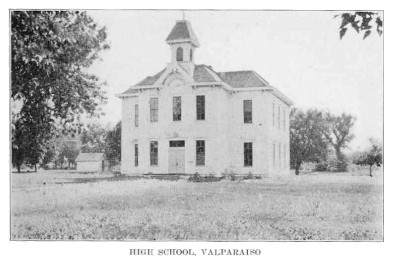
High School, Valparaiso
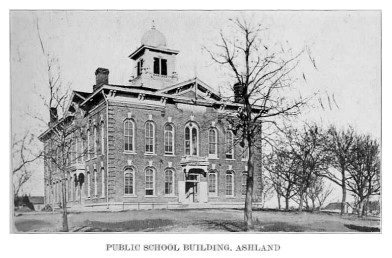
Public School Building, Ashland
PAST AND PRESENT OF SAUNDERS COUNTY 139
on section 10 and during that winter a school was maintained with David March, afterwards county commissioner, as teacher. In 1872 the township issued bonds and with the resulting funds constructed four frame schoolhouses. The first school officers after the organization of the districts were: S. G. Chaney, director: John Harrell, moderator; and B. F. Omdorff, treasurer.
In the early part of 1872 a school was organized in Chester Precinct, at Willow Creek, and a sod schoolhouse was erected. On May 6th of that year a district school was opened with a Miss Wheeler as the first teacher. On July 10, 1872, M. M. Runyan and H. L. Stowitts made application to the county superintendent of schools to organize a school district, and in the following August the organization was effected, with M. M. Runyan as moderator, H. L. Stowitts, director and D. C. Hall, treasurer. The first school of the district was held at the house of J. J. Miller, with Mrs. E. E. Miller as teacher, during the following winter. A schoolhouse was built in October, 1873, by C. Riggs.
The first school district in Elk Precinct was organized in the fall of 1869 and a sod schoolhouse erected. J. P. Dunlap taught the first term of school here during the following winter.
The first schoolhouse in Richland Precinct was erected on section 32, in the summer of 1872, and during the subsequent winter Miss Belle Riddle taught the first school established in this locality.
In Center Precinct a school district was organized in 1869. A schoolhouse was built on section 16 and the following winter a school was opened therein, with a very small attendance.
In the winter of 1868-69 a schoolhouse was built upon section 29 in Newman Precinct and a school taught by J. Worley. A second schoolhouse was constructed upon section 14 in 1872 and during the winter Miss Ellen Moran taught the first class ever assembled there. A third schoolhouse was erected on section 8 in 1873.
HIGH SCHOOL WORK
The work in the Wahoo High School and other schools of similar scope of work, offers a very complete course of instruction, one that will adapt itself to the students from both the town and the country. A close inspection of the calendar of studies
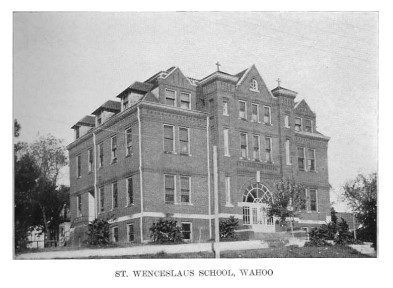
St. Wenceslaus School, Wahoo
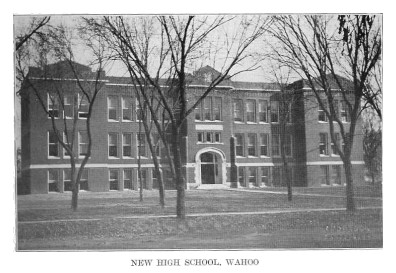
New High School, Wahoo
140 PAST AND PRESENT OF SAUNDERS COUNTY
will show that there is a minimum of positive requirements, with great latitude in the selection of those studies which parent, child and teacher shall judge best suited to the needs and capabilities of each student. The old classical course, with its Latin, advanced mathematics, etc., though still a fine training and approved in many educational centers, fails to meet the present requirements, that is, that the school shall better equip the pupils for the problems of life and gaining a livelihood, by giving them practical training in their selected vocation. A student has the choice of three well-defined courses; the agricultural or industrial course, the normal training or teachers' course, and the general or college entrance course.
Those preferring agricultural training will take a great amount of manual training, mechanical drawing and agricultural subjects. However, there are a few essentials such as algebra, English and history which must be taken in conjunction with any specialized course. The agriculture course comes directly as a result of the Shumway bill passed in the Legislature two winters ago, in which certain schools in the state, showing themselves to be justly qualified, are to receive state aid in the matter of agricultural education, one of the requirements being that the school district purchase or acquire a long time lease on five acres of farm land devoted exclusively to experimental work in connection with competent instruction. This plot has already been rented in Wahoo and is located directly east of the city power plant. As taken from the school laws for 1913 the following is a description of the work required in such agricultural high schools: "The instruction in such agricultural and industrial departments shall be of a practical character, dealing with soils, crops, fertilizers, drainage, farm machinery, farm buildings, breeds of live stock, live stock judging, animal diseases and remedies, production of milk and cream, testing of same, manufacture of butter and cheese, horticultural gardening, plants and such other subjects as have a direct relation to the business of farming, including bookkeeping and farm accounts. It shall also include systematic courses in manual training and home economics."
The normal training school is primarily for those who, upon graduation, wish to become teachers and includes such required
PAST AND PRESENT OF SAUNDERS COUNTY 141
studies as are specially marked in the calendar. Those taking the course will, in their senior year, take the county teachers' examination and with the ample review given in minor and major reviews each student is qualified, or should be, to pass an examination obtaining a second grade county certificate.
The third course, preparatory to college entrance, includes mostly the subjects required by the different colleges of the state and country for entrance. Some colleges admit without examination and others compel every new student to write upon several standard subjects.
DOMESTIC SCIENCE
The aim of a domestic science course is primarily to create an interest in and respect for all details connected with a home and its management; to develop habits of economy, foresight, good judgment, good taste and neatness; to give a child high ideals concerning the dignity and joy of labor; and to show the interrelation of individuals economically and their personal responsibilities.
Sewing was introduced into the curriculum of public schools several years ago for utilitarian purposes. It was felt that girls needed a knowledge of sewing and as they failed to learn at home the school provided this instruction. Material results were emphasized and little or no thought was given to the training of the brain through the hand. The object of the school is not, however, solely to provide a means of earning a living, but aims toward the full and equal development of the individual powers, that they may be used in efficient service to society. Psychologists studying the development of the brain, found that complete education included training in action, as well as in thought. Gradually, the entire attitude toward the training of the hand hanged, as more study was given to its proper function in the schools, and manual training is now felt to be as necessary in education as any academic study.
THE HIGH SCHOOL BUILDING
In the summer of 1914 there was completed the new high school building at Wahoo and it is one of the best in equipment and arrangement of any of its cost in the state.
142 PAST AND PRESENT OF SAUNDERS COUNTY
The basement is occupied on the southwest corner by the domestic science department, the main laboratory being 23 by 32 feet, with sewing and store rooms adjoining on the north. The kindergarten pupils are quartered in two grade rooms, one on each side of the main entrance. These rooms are about 19 by 21 feet. Homologous to the arrangement of the domestic science rooms in the southwest corner are the manual training and mechanical drawing rooms in the northwest corner. Having separate rooms for these two last courses is a material advantage, as the noise, jar and dust incident to a manual training room practically prohibits the teaching of a class in each subject at the same time. Another portion of the building extends toward the east, giving the whole building plan the general form of the letter T. The stem of the T, with the exception of the hallways flanked on each side, and the rooms utilizing space at the ends and above them, is occupied by only two rooms, the gymnasium below and the assembly room above. The gymnasium has a clear floor space of 40 by 57 feet, with a balcony on the west suitable for accomodating 250 people. Entrance to the boiler and coal rooms is obtained from the gymnasium. The steam for heating is supplied by two large tubular boilers, only one of which is required at a time. Several cars of coal can be stored in the bins.
The rooms in the southwest and northwest corners of the second floor are the best rooms in the building in point of space and lighting. On this floor are the botany and physics laboratories, lecture rooms, apparatus and dark rooms, board rooms, toilets, record room, commercial and typewriting rooms, principal's office and assembly.
On the third floor is the English room and library, class rooms, chemistry laboratory, mathematics, German and history rooms. The chemistry laboratory is equipped with water and gas, the latter being supplied from a private generating system, no city heat being available.
The roof is of the flat tar-gravel type and supported by three built up Howe wood trusses. The face of the building is of a dark red vitrified paving brick and the trimmings are of Bedford limestone.
Akin to the lighting is the heating and ventilation, a very important problem, but well met in the indirect radiation system
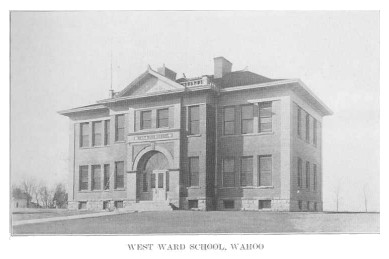
West Ward School, Wahoo
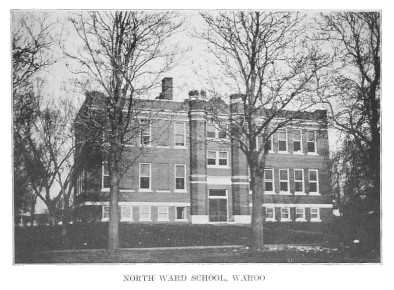
North Ward School, Wahoo
PAST AND PRESENT OF SAUNDERS COUNTY 143
which has proved so satisfactory in the North Ward Building. The radiators are located in flues through which a constant draft of pure air entering through ducts connected with the outside, circulates and enters the rooms in such an amount and at such a rate as to insure every individual a constant supply of the purest air. This system avoids drafts made by the opening and closing of windows.
NORTH WARD BUILDING
This building was completed in the summer of 1913 and was occupied at the opening of school in September. It is one of the best ward buildings in the state, being modern in every .
The class rooms are of a standard size and seated so as to have the pupils face a blank wall, the light coming in through a battery of windows at the left. The rooms are heated by an indirect system that insures an ample amount of fresh air; at the floor line are ventilating stacks which carry off the vitiated air.
WEST WARD BUILDING
This building was erected in 1906. It is very similar to the North Ward Building. It is modern, has steam heat, and, although slightly inferior in architecture to the other two buildings of the city, answers the purpose in an excellent manner.
EARLY SCHOOLS IN CEDAR BLUFFS
School districts in this county were first organized in 1878, District No. 1 being located at Ashland, No. 2 three miles northeast of Wahoo near the present county farm. Then the organizations followed the bluffs up the Platte River until the Cedar Bluffs district was organized as No. 13 in 1870. District No. 12 was five miles southeast of here, including all of Pohocco Precinct, No. 14 being the Morse Bluff District, which left practically all of Cedar Precinct of over forty sections in No. 13.
A. L. Pancoast of Jewel City, Kan., was in 1869 elected the first county superintendent. At the beginning of his term there were but three organized districts in the county and at the end of
144 PAST AND PRESENT OF SAUNDERS COUNTY
two years there were close to one hundred organized. Mr. Pancoast had his office at the postoffice and store of Jack Staats. For his services Pancoast was paid $3 per day for the time actually spent in his duties as county superintendent. The three schoolhouses which he found in the county were one frame building, one of sod and one of cottonwood hoards, sodded around the outside.
Walter Fleming of Morse Bluff was the second county superintendent and C. M. Whitney of Burkmere, S. D., was the third.
The first school taught in District No. 13 was in the claim shanty of Phillipi Sampson, who was also the teacher, near the center of the west half of the northeast quarter of section 34. The next spring, in 1870, a building was purchased from W. H. McCowan who had a store on Dr. L. L. Whitney's homestead. The building was moved to near the residence of John Schere and C. M. Whitney taught the first and second terms of school held there, followed by Mr. Charles Perky of Wahoo. At the time Mr. Whitney taught the number of pupils in the district was twenty-two and the county funds apportioned was $60.03. This building was used until the winter of 1875, when the new building erected near the home of William Schere was occupied. This building was used until 1877, when the district was divided. Miss Effie Thomas (Mrs. A. E. Stuart) taught the last term of school in that building. The early school directors were: W. H. McCowan, followed by Harvey Jones, J. H. Harley, Lewis Lichtenberg, W. R. Sampson, Jr., H. H. Brainard and again Mr. Lichtenberg. In 1886, when the Northwestern Railroad was built through and the Village of Cedar Bluffs platted, the question of dividing the district came up, and in the spring of 1887 a petition was circulated to this effect. R. H. Knapp was the first name on this paper. The petition was granted and the district was divided, Cedar Bluffs school became No. 17, No. 13 being the next west. The first school in the new district was taught by Louise Lampert (Mrs. David Young) in the building known as the Grange Hall. The first schoolhouse site was located near the present residence of John Killian, but it was later found that it would be impossible to divide the district with the building in that location.
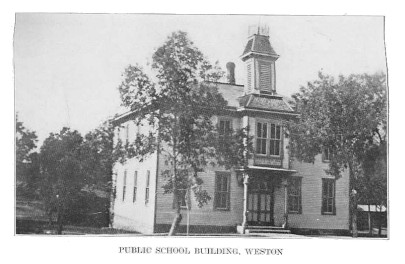
Public School Building, Weston
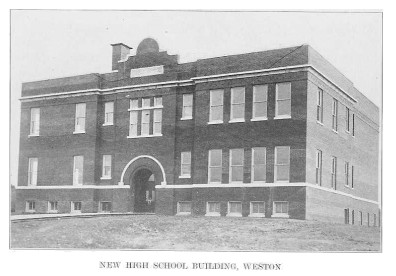
New High School Building, Weston
PAST AND PRESENT OF SAUNDERS COUNTY 145
The schoolhouse for the new district was n frame building built in 1888 by H. L. Browning and was thirty-six feet square and twenty-four feet high. Two rooms and a hall were on the ground and a hall and assembly room above. W. J. Lehr was the first principal with Mrs. Fred Gilbert in the primary room and only eight grades were taught.
Several years ago the board of education found that it would soon be necessary to erect a new school building. They began to set aside money into a building fund for that purpose. The sum accumulated until it had reached the amount of $13,000, when at the annual school meeting in 1913 the board was instructed to go ahead with the proposition. Frederick W. Clarke drew the plans and they were submitted at a mass meeting in the spring of 1914. At this meeting it was decided to vote bonds in the sum of $17,000. Chadwick & Johnson of Central City, by George F. Johnson, submitted the lowest and best bid for the general construction and Ray C. Killian of Cedar Bluff's for the heating and plumbing. The completed building was dedicated February 17, 1915. In every way the building is an excellent structure and easily among the best in the state for the cost. Modern school architecture is utilized completely.
ASHLAND BUILDING
In 1870 when the railroad came to Ashland, there also came a desire for a new schoolhouse. There was a great difference of opinion as to the size of the proposed building and the money which ought to be spent for the same. Some believed that $500 was enough, while others favored as much as $20,000. The sum of $15,000 in bonds was voted and subsequently increased to $20,000, in order to pay all of the bills. The building was begun in the spring of 1871 and completed in the fall of the same year. Three teachers were employed the first year, with Albert Nichols as principal. In 1872 Nichols went to a chair at the normal school at Peru and Miss Anna Glover was appointed to fill the vacancy. Following her for the first few years came: A. W. Vandeman, Albert Nichols, Hugh Dobbs, Mr. Rhodes, W. B. Shylock, C. E. Stratton, Mr. Hill, D. E. Reese, Morgan, Crabtree and Overholt.
146 PAST AND PRESENT OF SAUNDERS COUNTY
Weston is another town of Saunders County which has just completed a handsome high school building, located picturesquely on the top of the hill south of town. This building represents an outlay of about nineteen thousand dollars; it is built with a view to the best care of the students and is so arranged that a varied course of studies may be taken by each pupil without conflict.
It is reasonable to suppose that not many years will pass until every town of any consequence in the county will be equipped with a sanitary and adequately spaced building for the housing of the school children. The consolidation of schools has not yet been tried in Saunders County, but in the natural course of events will be at some future date; this will mean the collection of all the children for any prescribed district into one central school and, in order to properly accommodate the increased classes, buildings such as have been erected in Wahoo, Cedar Bluffs and Weston will be needed.
|

